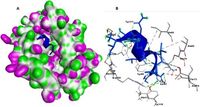The ongoing battle against COVID-19 faces a new ally: a multi-epitope vaccine construct (MEVC) designed to target the coronavirus spike protein. Researchers have laid the groundwork for this innovative vaccine by identifying key regions within the spike protein of SARS-CoV-2 that are crucial for eliciting robust immune responses, which could shield a substantial portion of the global population from rapidly emerging variants.
The study, harnessing advanced computational tools, zeroes in on critical B-cell and T-cell epitopes within the S protein, which plays a central role in the virus's ability to infect human cells. According to scientists leading the research, "This is a new era in vaccine development," as they seek to protect against the high mutation rates especially evident in SARS-CoV-2 variants.
COVID-19 first emerged in late 2019, resulting in more than four million deaths worldwide. The rapid spread of SARS-CoV-2, with its potential to mutate and produce new variants, has highlighted the urgency for effective vaccines. The novel approach presented by these researchers leverages predictive modeling to pinpoint 13 linear and 5 discontinuous B-cell epitopes, alongside critical T-cell epitopes that could foster a durable immune defense.
Vaccine development typically involves isolating the virus and using its components to provoke an immune response. However, this study opts for an innovative route by implementing immunoinformatics tools that predict which parts of the virus can safely stimulate the immune system without triggering alarming autoimmunity—a significant risk in traditional vaccines. The authors stated, "By using immunoinformatics tools, vaccines can be designed to identify effective epitopes, saving time and cost," thereby enhancing the vaccine's potential efficiency.
In their robust analysis, the researchers discovered that the proposed vaccine, covering both T-cell and B-cell epitopes, could engage more than 90% of the global population according to HLA allele distribution, ensuring broad applicability. Utilizing molecular docking studies, they found that the MEVC displayed a strong binding affinity with immune receptors TLR-3 and TLR-4, crucial for initiating innate immune responses. The study found that the binding energy and dissociation constants for these interactions suggest a powerful engagement capable of provoking significant immune reactions.
Furthermore, a detailed computational simulation of the immune response following the administration of the MEVC indicated promising results. Levels of immunoglobulins—IgM and IgG—soared in simulation studies, suggesting that the vaccine could effectively stimulate immune cells responsible for targeting SARS-CoV-2. Immune simulations showed a marked increase in macrophages and dendritic cells post-vaccination, alongside notable production of crucial pro-inflammatory cytokines essential for establishing an effective defense against viral infections.
Through a process of iterative modeling, the final vaccine sequence was constructed, incorporating small protein segments with optimal characteristics for inducing immune responses while minimizing adverse effects. The study highlighted that the vaccine exhibit non-allergenic, non-toxic properties and displayed significant stability, making its in silico designs promising candidates for subsequent wet lab testing. As the authors emphasized, "We need further wet lab experiments to confirm the vaccine's binding affinity with TLR-3 and its interaction with CTL epitopes and HLA molecules," underlining that validation through empirical methods is critical for advancing to clinical applications.
If successful, this MEVC could revolutionize defenses against SARS-CoV-2, pooling together cutting-edge computational predictions and structural biology insights that might significantly speed up vaccine deployment strategies in response to evolving variants. The potential for a vaccine that bridges T-cell and B-cell responses ensures an adaptive, long-lasting immunity strategy against a virus that continues to challenge global public health.
The outcomes of this cutting-edge research signify an essential step toward not only addressing current realities but also potentially preparing against future variants that could arise. The scientific community remains on the lookout for further evaluations and testing to cement this vaccine's role in the global arsenal against COVID-19. As researchers continue to explore these promising avenues, the hope is for safe, effective, and globally accessible COVID-19 vaccines to become a reality.

